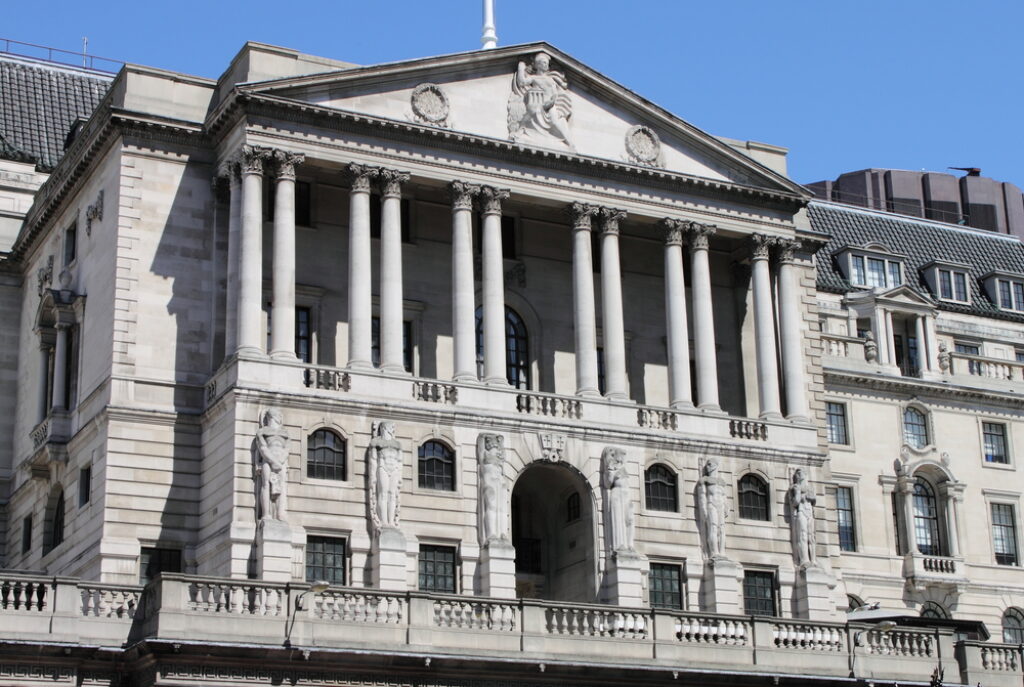The Bank of England’s Monetary Policy Committee has maintained the base rate at 5.25% as many industry experts predicted, with millions of homeowners and billpayers breathing a sigh of relief.
The MPC voted by a 6-3 majority to maintain the base rate at 5.25%. Three members preferred to increase it by 0.25 percentage points to 5.5%.
This is now the third time in a row that the base rate has been frozen, with the latest hold decision widely predicted by industry analysts and experts who suggest it has reached its peak.
It also comes hot of the heels of the US Federal Reserve last night signalling the end of its tightening cycle.
But as to when the two-years of rate hikes will start to unwind is under fierce debate, with some suggesting earlier this week that it could be from mid-2024 while others indicated it could be at the tailend of next year as policy makers hold firm for longer.
Rob Clarry, investment strategist at UK wealth manager Evelyn Partners, offered this fresh perspective: “Money markets have moved to price in as many as four 25bps cuts from the MPC from early next summer – which would mean a bank rate as low as 4.25% by the end of 2024.”
Either way, since the base rate was first raised from the historic 0.1% low in December 2021, inflation peaked at 11.1% before it has now softened to 4.6%. This means for the first time in 15 years, the base rate is higher than inflation.
While inflation is down from the eye-watering double-digit figure, it’s still above the 2% target and nonetheless, prices are still rising, just at a slower pace, with the cost-of-living crisis very much at the centre of billpayers thoughts and policymaker strategies.
Meanwhile, the latest GDP figures showed the UK economy contracted 0.3% in the month to October while zero growth was recorded over the quarter. Elsewhere, wage growth is still at the upper end of the comfort zone at 7.3% (excluding bonuses, 7.2% including them) between August to October.
Minutes of the MPC meeting read: “In the most likely, or modal, November Report projection, conditioned on a market-implied path for bank rate that had remained around 5.25% until Q3 2024 and then had declined gradually to 4.25% by the end of 2026, CPI inflation had been expected to return to the 2% target by the end of 2025 and to fall below the target thereafter. The Committee had continued to judge that the risks to its modal inflation projection were skewed to the upside, such that the mean projection for CPI inflation had been 2.2% and 1.9% at the two and three-year horizons.
“There remained upside risks to the outlook for wage growth, including from the possible effects of the recently announced increase in the National Living Wage. Relative to developments in the United States and the euro area, measures of wage inflation were considerably higher in the United Kingdom and services price inflation had fallen back by less so far.”
What does the base rate hold mean for savers and borrowers?
Paul Broadhead, head of mortgage and housing policy at the Building Societies Association, said: “For many mortgage borrowers it might feel like we’ve finally turned a corner, with inflation reducing and new mortgage rates nudging down. However, whilst the Bank of England’s Financial Policy Committee recently reported fewer households with significant financial vulnerability, we’re not out of the woods yet.
“Almost half of today’s fixed rate mortgages are on rates agreed before the bank rate started to increase in December 2021. Borrowers on these mortgages will be coming off their fixed rates in the next three years, and should be preparing for a significant increase in their mortgage payments.”
Figures from UK Finance revealed around 1.6 million mortgage deals are set to expire next year. According to Moneyfacts data, since the start of December 2021 when rates started to rise, the average two-year fixed rate has risen from 2.34% to 6.04%, while the average five-year fixed rate has risen from 2.64% to 5.65%.
Meanwhile, the average standard variable rate (SVR) stands at 8.19%, up from 4.40% two years ago.
For savers, Mark Hicks, head of active savings at Hargreaves Lansdown, said: “The pause is likely to cement expectations that we’re at the peak right now, and the next move will be downwards. This is already being priced into the market, and we’ve seen rates come down. The market isn’t expecting imminent and rapid falls in the Bank of England rate, so we’re not seeing massive drops in savings rate. This is more a case of a solid downward trend we expect to endure in the coming months.
“We’re also seeing a flattening of the yield curve, which means you’re getting very similar rates on easy access and fixed rate savings. You will need some of your cash in an easy access account for emergencies, but if you’re holding some for at least a year, it still pays to consider a fixed rate savings account, because that rate is guaranteed whatever happens to rates in the interim.”
He added: “Despite the fact we’re seeing rates come down, they’re still at the kinds of levels we could only have dreamt of when rates started rising two years ago. Back in December 2021, Bank of England figures showed the average easy access account paid 0.09%, whereas the best on the market are offering over 5%. It means that although rates are on their way down, there are still some great rates around if you look beyond the high street giants to smaller and newer banks and cash savings platforms.”
While some may be relieved by the hold position, Richard Lane, director of external affairs at StepChange debt charity, said households are facing little respite from financial woes as we approach the New Year.
He said: “Our latest polling has shown just how difficult the last two years has been on people’s finances, with one in four people now saying they will struggle to afford Christmas this year. Combined with the increase in energy bills from January, stubbornly high interest rates could spell further financial difficulties for both mortgage holders and renters well into 2024 and beyond.
“For anyone struggling with mortgage payments, it’s important to contact your lender as early as possible to let them know. Many lenders have signed up to the Government’s Mortgage Charter introduced earlier this year which allows people to make adjustments to their mortgage such as temporarily switching to interest only or reducing payments without impacting their credit score.”





